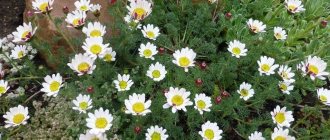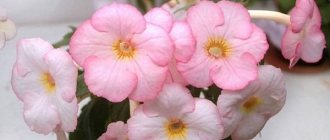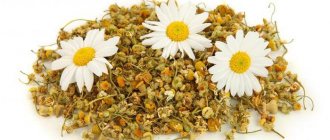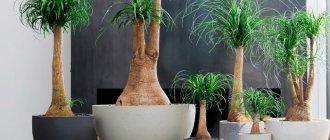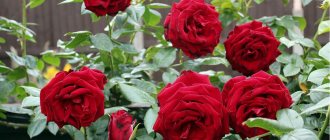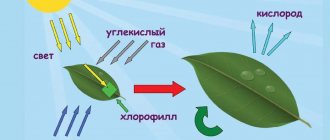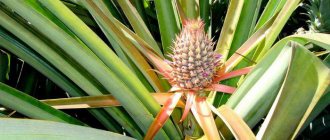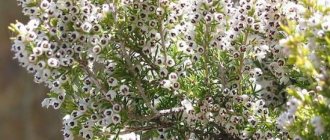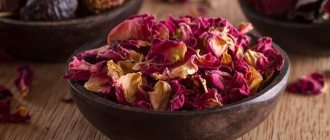Anacyclus
The plant really strongly resembles chamomile in appearance. The variety has about 10 subspecies , which are annual and perennial. The petals of the opened bud have a double color: they are white on the inside and pink on the outside. The flower reaches a diameter of 5 cm.
Basically, the varieties look like small bushes creeping along the ground. As a member of the aster family, anacyclus is subject to the solar rhythm: it opens at dawn and closes during sunset.
Arctotis
A rather tall crop, which sometimes grows up to 130 cm. In difficult conditions, the flower develops poorly and grows only up to 25 cm. The species is divided into two subspecies: stochafolium and hybrid.
Both named subspecies are characterized by unusual buds with petals colored red or bronze at the center with a gradual transition to yellow. The buds open only in sunny weather, and you won’t be able to admire them in the rain.
Plants with colorful inflorescences
Some plants have multicolored inflorescences. Often 2-3, and sometimes even more, shades are combined on one petal. Thanks to this, the plants look very impressive and exotic.
Multi-colored daisies are called:
- Gaillardia spinosa;
- Osteospermum;
- Gazania;
- Venidium;
- Arctotis;
- Ursinia umbilicus and other similar flowers.
Gaillardia spinosa is a perennial shrub whose stem height reaches 90 cm. The diameter of the flower baskets is usually from 7 to 12 cm. The tubular flowers located in the center are dark red or burgundy in color. The petals of this plant are three-toothed. Along the outer edge they are colored yellow, and closer to the middle - red or purple. In some varieties they are arranged in several rows.
Gaillardia bushes look like this:
This plant is sometimes confused with helenium, some varieties of which have almost the same color of flower baskets.
Many varieties of osteospermum are also often called colored chamomile. Their inflorescences can combine a variety of shades: pink, white, red, lilac and others.
Here the photo shows osteospermum tricolor:
An abundance of color variations is also inherent in gazania. Its inflorescences are very large, and its petals are pointed. They can combine 3-4 color shades at once. The photographs show some plant varieties:
Venidium boasts even larger and brighter flower baskets. Their diameter ranges from 10 to 14 cm, and the height of the bushes can reach 80 cm. Its reed flowers have pointed or rounded edges. They come in white, yellow, orange, red and some other colors. Moreover, in almost all varieties the center is black, and around it, on the edge flowers, a ring of a contrasting color is outlined - brown, burgundy or purple.
A similar color is found in Arctotis. Some varieties also develop a ring of a different color around the core. At the same time, its petals are more pointed, and the diameter of the baskets is slightly smaller.
Here the photo shows Venidium bushes:
And here is arctotis:
And this is Ursinia umbilicalis:
As can be seen from the photograph, its marginal flowers are colored at the base in a rich brown color, which gradually turns into burgundy, and then into bright orange.
Venidium
These are white, pink, orange or yellow flowers similar to daisies. They have a brown or dark red core. When open, the bud reaches 10 cm in diameter , and the length of the stem is between 70-80 cm. The species is rarely grown in open ground, more often it can be found in home pots and flowerpots. Flowering begins at the end of June and continues until the end of September.
Nivyanik Luna and chamomile: differences
Calla lilies flowers - what they look like and what the varieties and varieties are called
Despite the fact that cornflower has a number of similarities with chamomile, experts count a large number of differences between ornamental crops, among which it is worth highlighting:
- the tap root system of the cornflower;
- bright scarlet color of the root system of Luna;
- the height of the cornflower bush (popovnik) is in the range of 25-80 cm;
- basket-shaped popovnik inflorescences consist of flowers of 2 types (ligulate and tubular);
- elongation and integrity of the leaf plates of the cornflower with the presence of small notches along the edges.
Gatsania
The flower has an incredible variety of shades: yellow, lilac, red, orange, etc. There are also two-color and striped varieties. Externally, gatsaniya really resembles a chamomile, only with brighter and more colorful petals. Gradient varieties, where one color gradually gives way to another, do not allow you to take your eyes off the bush.
Under natural conditions, there are about 40 species that are resistant to frost, direct sunlight, drought and high temperatures. Flowering starts at the beginning of summer and continues until night frosts. The height of the bush is within 30-40 cm. The flower retains its appearance for a long time after cutting.
Gatsania is grown in open ground, pots and flowerpots. It combines well with other plants in the flowerbed and looks impressive when planted alone. The species is used to decorate paths, borders and rock gardens.
The name of the flowers most similar to daisies
There are many plants with flower baskets and daisy-shaped petals. Their colors, petal sizes, and stem types are different and different from each other. Some of them are perennials, others require annual planting. The following flowers are considered the most common and familiar from grandmothers’ beautiful front gardens.
Cornflower (Leucánthemum)
Photo: terranovanurseries.com
Garden chamomile (Asteraceae family) is considered the master in any area. A perennial, easy-to-care plant that can emerge on its own and easily fill all the beds. Beautiful, tall stems (up to 120 cm) with snow-white flowers grow when planted in a sunny place and with the necessary care. The flower has many popular names. Among them are whiteflower, whitefish, Maryasha, kupalka, kukishka, etc. Meadow chamomile is characterized by a branched stem (not a single trunk, like that of cornflower) with several flowers. Breeders have obtained many chamomile hybrids with large double inflorescences (Shasta chamomile). Among the chrysanthemum-like varieties of chamomile, winter-hardy beautiful varieties “Alaska” and “Aglaya” appeared.
Calendula (marigold, Calendula)
Photo: m.yandex.com
Yellow suns (of different shades) are popular with gardeners. Their healing properties for people, plants growing nearby, the ability to reproduce by self-sowing, and withstand winter cold have made the orange flower a permanent resident of any area. There are different varieties of plants from the Asteraceae family: low-growing, tall, double, orange, yellow, golden.
Cosmos
Photo: yandex.uz
It is difficult to imagine flower beds on the site without these garden flowers. A multi-colored lace of bright inflorescences similar to daisies creates a magical, fairy-tale world in the garden and on the lawn. Thin carved leaf blades on a high stem form a special background, emphasizing the beauty of the flowers. They are painted in different shades of red, purple, and white. Cosmea grows on any soil and is not afraid of wind or cold weather. The bush gains full strength at the end of summer, beginning of autumn. He becomes big and unusually beautiful.
Echinacea (Echinacea purpurea)
Photo: pixabay.com
Of the 10 known flower species, Echinacea purpurea is the most commonly grown flower. Other varieties may have cream, red, or yellow flowers. All parts of the plant are used in official, traditional medicine recipes.
Gerbera
Photo: pinterest.ru
There are 100 known flower varieties obtained by breeders. They have a large number of tubular, terry, curly, pointed types. The flowers are borne on stems of varying heights from summer to November. Large flowers are painted in dark cherry, pink, orange, and lilac shades. They look like a big daisy. Flowers do not cause an allergic reaction. They are good to grow for gift bouquets.
Doronicum
Photo: thomasdstone.blog
Otherwise, the plant is called gooseberry. Cut flower stalks with large flowers can stand in water for a long time, maintaining their decorative qualities. Of the 40 varieties of the non-capricious perennial, 10 species are most often grown. They decorate the area from May until late autumn, when the bushes begin to bloom again.
Gerbera
The plant is similar in structure to a chamomile, but has purple, yellow, cherry, orange, cream and classic white petals. Such diversity attracts gardeners; resistance to adverse conditions, as well as wide possibilities for use in bouquets, also play an important role.
There are double gerberas, and their numerous petals are tubular, curly and pointed. The species is grown outdoors and at home. Flowering starts in the summer months and lasts until November. The exact dimensions of the bush and the open bud depend on the variety.
Doronicum
The second name of the species is Kozulnik. There are about 40 varieties, but often only 10 are used. The height of the bush varies in different varieties from 0.5 to 1 meter. The flowers are yellow and quite large - the diameter reaches 10 cm. Flowering begins in May and lasts on average 1.5 months. At the same time, the plant can be pleased with the repeated release of buds in mid-summer or early autumn.
When cut, the flower retains its attractive appearance for a long time. You should know that the plant is poisonous. It is not recommended to plant Doronicum under trees - it will be suppressed.
Calendula (marigold)
The following daisy-like flowers are incredibly popular among people who have a local area. They belong to the Astrov family and are distinguished by their unpretentiousness to external conditions. Depending on the variety, the bush grows from 20 to 65 cm in height .
The open buds are quite compact, the petals are deep orange. Having planted marigolds in the garden once, you will not need to buy seeds for the next year - the plant actively reproduces by self-seeding, and if its spread is not limited, it will quickly occupy the entire free territory.
Coreopsis
The flower has yellow petals with a jagged edge and brown spots at the base. Pedicels grow up to 60-100 cm in height, depending on the variety. The diameter of the opened bud is within 3-7 cm. Flowering begins in mid-summer and lasts 2-2.5 months. Flower baskets can be regular or double, and the shade of the petals also varies.
The crop is suitable for growing in large front gardens and massive flower beds.
Low-growing "daisies"
Flowers from this selection are grown in borders, mixborders, and at the foot of rock gardens. They are also suitable for growing in pots and decorative compositions.
| Anacyclus (anacilus) | |
| The height of this plant does not exceed 5-10 cm. Anacyclus has creeping shoots that are arranged in a circle and form clumps. Flowering occurs in May-June. The inflorescences are white with a yellow center or completely yellow. The perennial Anacyclus depressum has dark pink outer ligulate flowers, like all the buds. During rain and at night, the flowers close. The flower requires a sunny area with well-drained light soil. | |
| Arctotis short-stemmed, stemless, hybrid | |
| Various varieties of hybrid, stemless, short-stemmed arctotis are often grown in culture. Their height usually does not exceed 15-20 cm. The colors are varied: from white to deep purple. The plant loves well-lit areas. They grow best on rocky soil. They are drought and cold resistant. They bloom from July to September. | |
| Gatsania | |
| Gatsania (gazania) is a perennial southern plant, which in the middle zone is usually grown as an annual. Depending on the species, it blooms from early summer to mid-autumn, until the onset of frost. The height of gatsania usually does not exceed 30 cm. It is suitable for growing in containers - in this case it can be grown as a perennial. It looks decorative due to the variety of color options. On sale you can find many varieties with variegated petals. Easily propagated by seeds and cuttings. Drought-resistant, can withstand frosts down to -7 °C. | |
| Helichrysum daisy flower | |
| Helichrysum of this species is a low-growing perennial that forms a clump up to 50 cm in diameter and up to 8 cm in height. White inflorescences, similar to daisies, rise above a mat of bluish leaves on low peduncles. Daisy-flowering helichrysum blooms all summer, from June to August. This plant grows very quickly and does not have any special care requirements. | |
| Doronicum Clews | |
| Doronicum Clews grows up to 10-30 cm in height. Inflorescences with a diameter of 3-6 cm are similar to chamomile, bright yellow. Blooms in July-August. Winter-hardy, loves open sunny places. Prefers loose, well-drained, fertile soil. | |
| Calendula officinalis | |
| Calendula officinalis can grow up to 70 cm, depending on the variety, but it cannot be called a tall “giant”. The average “height” of calendula is 20-50 cm. Propagates by self-sowing. Unpretentious. Used for making herbal teas. Calendula repels many pests, so it is recommended to plant it along the beds. | |
| Cosmea bipinnate | |
| A herbaceous annual that forms spreading bushes up to 50 cm high. The color range is varied: there are varieties with pink, purple, burgundy petals. The inflorescences are very large, sometimes exceeding 10 cm. Propagates well by self-sowing. Can be grown in containers on balconies and patios. | |
| Coreopsis pink | |
| The height of pink coreopsis is up to 40 cm. The bushes are quite lush and spreading. The inflorescences are small - up to 2 cm in diameter. Depending on the variety, they are pale or bright pink. This perennial grows well in one place for several years. For planting, choose well-lit areas with loose, light, fertile soil. Blooms from July to September. To increase frost resistance, after flowering the above-ground part of the plant is cut off. | |
| Perennial daisy | |
| The height of daisy bushes does not exceed 30 cm. Unpretentious, but needs regular hydration. The optimal soil type is light loam rich in humus. Tolerates partial shade. There are varieties with different colors of inflorescences: Beethoven (pink), Schneebal (snow-white), Rob Roy (red), Etna (dark pink), etc. There are also varieties with an unusual shape of inflorescences: the Tasso and Rominette series (pom-pom inflorescences), the Habanera series (lancet inflorescences). | |
| Ursinia dwarf | |
| The height of dwarf ursinia is only 8-15 cm. The inflorescences are light orange. The center of the flower is darker, ocher. Flowering lasts from July to September. For ursinia, well-lit, drained areas are selected. Can be grown in containers. | |
| Arctic chrysanthemum | |
| One of the shortest types of chrysanthemums - up to only 30 cm in height. Flowering is very late, falling in autumn (from late September to November). Inflorescences similar to chamomile can be either white or another shade. It grows quickly. Forming curtains. Loves humus-rich soils and sunny areas. Frost-resistant. | |
| Chrysanthemum Korean | |
| Korean chrysanthemums are a group of hybrid chrysanthemums whose flowering time, growth, color, inflorescence shape and other features vary depending on the variety. The height of Korean chrysanthemum bushes does not exceed 30-50 cm. As a rule, flowering occurs in late summer - autumn. These chrysanthemums are planted in well-lit, windproof areas. | |
Cosmea
The plant often evokes associations of summer warmth and comfort. Its distinctive feature is its low maintenance and self-seeding. Once you remember what these colorful daisies are called and look like, they can be distinguished in private flower beds, as tapeworms on lawns, in city park areas and along borders. A lush carpet of greenery and bright buds will decorate the garden, covering bare areas of the territory and emphasizing straight lines.
The crop easily copes with prolonged drought and heat, is undemanding to the presence of various substances in the soil, and is resistant to frost. The petals come in many shades of red and purple, and white varieties are also found. The buds are located on straight stems growing within 0.7-1.5 meters. Cosmea is used as a tapeworm and in the company of other plants. If there are empty spaces in the flowerbed, this flower often saves the day, since it manages to easily and quickly cover all the flaws.
List of indoor flowers
Elements of indoor floriculture allow you to continue the summer and make the winter landscapes outside the window of your own home warm and beautiful. Flowers reminiscent of summer chamomile are considered especially pleasant and unexpected. Modern technologies for growing potted plants help create home beds from any plants. The lack of light is compensated by special radiation sources. Watering, fertilizing, and pest control are carried out according to the recommendations of specialists. Back in the 13th century, the first winter garden appeared in Europe. Nowadays, in any big city, the windows of greenhouses are glowing, and tropical palm trees are blooming in theaters and offices.
Photo: zadenplanten.nl
The assortment of indoor flowers has been formed over two centuries from a large number of proposals. The most popular indoor daisy flowers are gerberas and chrysanthemums. There are many varieties of Korean chrysanthemum of different colors with different flowering periods. Dwarf species with double inflorescences look beautiful on window sills and shelves. Tall species are used for growing in open ground for the purpose of decorating flower beds and subsequent cutting.
Gerbera jamesonii H. Bolus is considered the ancestor of indoor gerberas. Proud, fragile chamomile (gerbera) is brought from Holland in the fall. In pots there is a flowering plant with double, simple flowers of orange, red, white, pink with a yellow chamomile center. The plant loves light and warmth. The trade offer also includes species of small Gatsania daisies. Some varieties of multi-colored bushes have flowers with a gradient color. In pots and containers they are taken out onto balconies, verandas, and open ground.
Nivyanyk
In fact, this is chamomile, namely its garden variety. Nilet belongs to the aster family and is often grown in our gardens. It is chosen due to the lack of special requirements for care, soil, and watering. It tolerates frost well. The bush grows up to 120 cm, the exact figures depend on the variety.
Flowering is accompanied by the opening of a white bud up to 10 cm in diameter with a yellow center. The process is repeated twice during the summer season: in May or June, and a second time in August or September.
Plants that do not belong to the genus Matricaria, but are often called daisies
Chamomiles belong to the family of aster plants, the list of species of which reaches almost 30 thousand. Most of them have a similar inflorescence structure, due to which these inflorescences look similar to each other, and the species are often called daisies if they do not know the exact name.
Moreover, even in the scientific community, some species of other genera are traditionally called daisies, since this has happened historically and the name has already been firmly assigned to the plant. For example, these are Persian and Dalmatian chamomile (representatives of the genus Pyrethrum), dog chamomile and field chamomile (representatives of the genus Pupavka), and Roman chamomile.
Most often, chamomile is confused with Roman chamomile. Its correct name is the noble navel (Chamaemelum nobile). It looks like this:
It has larger leaves and dense, opaque bushes, and there is no cavity in the inflorescences. Also unlike Matricaria chamomilla, it is a perennial plant.
Sometimes yellow daisy is also called yellow chamomile or yellow chamomile (Anthemis tinctoria). It can be distinguished from representatives of the genus Matricaria by its yellow marginal flowers:
Doronicum orientalis is also often called yellow chamomile:
Very similar to field daisies and odorless tripleurospermum inodorum, which previously belonged to the genus Matricaria and was known under the synonymous names Matricaria inodora and Matricaria perforata merat. Its characteristic difference is the absence of odor in the inflorescences.
Another closely related species is the Hooker's hooker (Tripleurospermum hookeri, or Matricaria hookeri), but it most often grows on sea coasts.
Some sources also include tansy or feverfew (Tanacetum parthenium) in the genus Matricaria. It can be found under the name Matricaria parthenium. When comparing pyrethrum with matricaria, you will notice that their inflorescences are similar, but the leaves of both plants are very different. In pyrethrum they are pinnately dissected and deeply cut. This difference is clearly visible in the picture:
Tansy, or feverfew (Pyrethrum corymbosum), like tansy, is a perennial plant. It is widespread in the European part of Russia, Crimea, Western Europe and some other regions. It grows mainly in deciduous forests and forest clearings. You can distinguish it from real daisies by the characteristic structural features of the bush and leaves. Its stems are single, branched at the top, and sparsely covered with pinnately dissected leaves with ovate-lanceolate lobes. The inflorescences contain from 3 to 15 flower baskets. Pyrethrum scutum is listed in the Red Book of some regions of Russia and Ukraine.
Other types of pyrethrum also have a certain similarity with matricaria. The two most famous of them are popularly called Persian (Turkish) chamomile and meat-red chamomile, which can be distinguished from true representatives of the genus Matricaria by the unusual color of the marginal flowers, which in these plants is pink and red. Also, Persian and Dalmatian chamomile (the latter is similar to the chamomile in color) have significantly larger inflorescences.
The wild-growing stinking navel, or as it is also called dog chamomile, is very similar to pharmaceutical chamomile. It is distinguished by the sharp unpleasant smell of inflorescences.
Annual and compound-leaved polypetalous plants (Erigeron annuus and compositus) also have an external resemblance to matricaria. They grow mainly in North America.
A variety of daisies, which are characterized by a yellow core and white petals, can also be confused with daisies.
Meadow daisies are called leucanthemum vulgare. It is distinguished by single inflorescences, the diameter of which ranges from 2.5 to 6 cm.
Large flower baskets are also characteristic of anacyclus. Their diameter is about 5 cm, and they do not grow singly, but in corymbose inflorescences. This plant can be found in the Middle East, Turkey and Mediterranean countries.
American chamomile is called Echinacea purpurea. The height of its stems is 90-100 cm, and the diameter of the inflorescences is about 15 cm. It is also distinguished from chamomile inflorescences by the purple color of the marginal flowers.
Osteospermum
These flowers are exactly like daisies, only with purple or red petals. The varieties with white flowers are especially similar. It is recommended to plant in open areas exposed to direct sunlight. At the same time, osteospermum shows high resistance to life in regions where cloudy and rainy weather prevails.
The crop is grown in the form of annual or perennial plantings. The height of the bush varies between 25-100 cm, the opened bud reaches a diameter of 4-10 cm.
Growing technology and care features
Yellow daisies are considered very unpretentious flowers. Therefore, they can be planted directly into the soil with seeds.
In spring, planting can be done starting in May, and in autumn - in October.
If in doubt, growing seedlings can be carried out in compliance with the following recommendations:
- in February or March, plant the seeds in the ground - you can use a universal substrate with the addition of sand or peat;
- control lighting and regularly water seedlings;
- when 3 leaves appear, perform planting dives;
- by May, young flowers will have 5 leaves.
The crop can be grown in seedlings.
It is recommended to plant chamomile in well-lit areas. Loose, slightly alkaline soil is perfect for this plant. In this case, you need to make depressions measuring 20 cm and plant the bushes by transshipment. After which they need to be watered abundantly.
A couple of weeks after planting, it is recommended to apply mineral fertilizers.
After which you need to provide the culture with proper care. It is recommended to adhere to the following rules:
- Choose the right soil. Yellow daisies do not grow well in acidic, clay or heavy soil. The best option is a light, slightly acidic substrate with a high content of nutrients. The root system of yellow daisies is on the surface. Therefore, loosening or digging up the soil is not recommended.
- Water the bushes in a timely manner. Since the chamomile root system is located near the top layer of soil, the plant requires frequent but moderate watering. To do this, it is recommended to use warm, settled water.
- Spray the plantings regularly. This must be done in hot weather. This procedure is recommended to be carried out in the evenings. At the same time, it is important to remember a sense of proportion. Excess moisture can cause illness.
- Monitor humidity. Yellow daisies do not tolerate waterlogging well, so they should not be planted near large trees or in lowlands.
- Apply fertilizers on time. In spring, bushes need complex feeding. The flower requires mineral and organic substances. At the end of August, during the development of new rosettes, nitrogen fertilizers should be applied.
Yellow daisies are resistant to cold weather. Therefore, if there is enough snow in winter, they may not need to be insulated.
If the winter is not expected to be too snowy, you can cover the plantings with compost or spruce branches. At the same time, the plant easily withstands spring frosts. This even applies to flowering crops.
It is important to water the bushes in a timely manner.
Pyrethrum
Another double of the chamomile, which is a highly branching bush, 20-50 cm high. The opening buds can reach 8 cm in diameter, their petals are colored white, pink, crimson, red and lavender. The flower is grown as an annual and perennial crop and has an effective ability to self-sow. Planting is possible in almost any soil, but waterlogging and stagnation of water should be avoided.
Flowering begins in May and continues for a long period. The aroma is strong and quite specific.
Rudbeckia
The flower belongs to the tall category, the minimum height of the bush is 50 cm, and the maximum reaches 2 meters. The plant has no special care requirements; moreover, it is perennial and can decorate the garden in one place for up to 5 years.
The daisy-like flowers come in yellow, pink, scarlet, orange and cream. There are two-color species, where the darker base becomes lighter as it approaches the edge of the petal. There are 40 varieties in total.
Diseases, pests and control measures
Yellow daisies often suffer from attacks by aphids and thrips, which absorb all the juices from the flower. To cope with pests, it is recommended to use various insecticidal preparations.
Excessive soil moisture leads to the appearance of gray rot on the bushes. In this case, the plants need to be thinned out and damaged fragments removed. Correction of watering is of no small importance.
With excessive moisture, the flower suffers from powdery mildew and rust. In such a situation, the amount of watering must be reduced, and the affected plant fragments must be removed.
Fusarium on daisies
Fusarium is considered another dangerous pathology to which yellow daisies are susceptible. It begins with rotting of the root system. This causes the lower leaves to wilt and turn black. Then the remaining fragments suffer.
The disease actively develops in conditions of high humidity. It quickly attacks flowers. Since the disease first damages the roots, the plant cannot be saved. In such a situation, you need to immediately dig up and burn the bush.
The place where the infected chamomile grew needs to be watered with a solution of copper sulfate. Plants that grow nearby should definitely be treated with fungicides.
Ursinia
The shape of the flower is similar to a chamomile, but the color of the petals is very different. They are mostly golden with a hint of orange. The color is bright and rich, easily attracting attention. It is noteworthy that the inside of the flower is lighter than the outside. For example, a petal that is yellow on the inside will be brownish-purple on the back. The opened buds have a diameter of 5-6 cm.
The shoots grow up to 30-60 cm, covered with dark green foliage. The crop is grown both annual and perennial. It is resistant to negative temperatures and is undemanding to living conditions. Flowering continues until night frosts appear.
Chrysanthemum
A perennial or annual plant with many varieties. Flowers are located on a separate stem or are included in massive inflorescences. The petals are cream, lilac, yellow, purple and lilac. The height of one branch varies depending on the variety, in rare cases it can grow up to 160 cm. The plant is stable after cutting.
The chrysanthemum variety Bacardi deserves special attention. You should remember the name and look at the photo, because chamomile-like flowers can be used to create a wide variety of compositions. The variety has white, densely set petals and a yellow center, which together gives an incredible similarity. There are up to two dozen buds on one large stem, so literally 3-5 branches allow you to form a lush, beautiful bouquet.
In addition to the standard color, the petals can be red, yellow, pink, or cream. This flower is popular among florists - its inflorescences are painted in various shades, sprinkled with sparkles, and decorated with ribbons.
The Bacardi variety is grown outdoors and at home. It is placed on sunny lawns and provides abundant watering.
"Daisies" blooming until autumn
In this selection, we have collected not only chamomile-like plants that bloom in the fall, but also those, most of whose flowering occurs in the second half of summer, but also covers September. In a word, those that are in bloom right now.
Arctotis
Like all daisy-like flowers, arctotis has saucer-shaped inflorescences. Petals can be either white or orange, ocher, violet, purple, yellow, pink. Externally, the inflorescences are also similar to gerbera.
The height varies depending on the type and variety of the plant, but usually does not exceed 15-20 cm. The exception is Arctotis steaholifolia, which can reach 1 m in height.
The most common perennial species - Arctotis hybrid, Arctotis short-stemmed, Arctotis stemless, Arctotis stochasolista - are grown as annuals or biennials.
Arctotis bloom from July to September.
Gatsania
Gazania (or gazania) is an African beauty that from afar can be mistaken for a daisy. But upon closer examination, it is easy to notice that, unlike the modest daisy, it boasts a huge variety of petal color options: there are yellow-orange, pink, and purple. Moreover, many of the flowers have a bright colored ring at the base or striped petals.
The size of the inflorescences can exceed 10 cm in diameter. Some species and varieties of gatsanias may resemble gerberas.
Flowering continues all summer until autumn. Gatsania hybrid and long-arrowed Gatsania bloom in the second half of summer and bloom until mid-autumn.
Gerbera
Breeders know about 7 dozen species of gerberas. Depending on the variety, the height of the peduncles can be from 25 to 60 cm. The color of the inflorescences can also be varied - white, orange, red, yellow, pink, crimson.
Gerberas love sun and warmth, so in the middle zone they are grown in containers on balconies and patios, in pots at home or in greenhouses.
Venidium
Venidium is an infrequent guest in our gardens. Typically, it is grown in containers and pots.
The most common type of this flower is lush Venidium. It has quite large flowers - their diameter reaches 10 cm. The plant itself grows up to 70 cm.
The flowers have a dark center and a bright orange-purple ring around it.
Venidium blooms from late July until frost.
Cosmea
Cosmea (or cosmos) is a popular plant in the gardens of the middle zone. This is a fairly “independent” herbaceous annual that does not require special care and reproduces without problems by self-seeding.
The most popular of this flower is cosmos bipinnate . Its flowers are most often simple, but there are also double varieties. The colors of the petals are varied: purple, lilac, pink.
has sulfur-yellow inflorescences in ocher-orange tones. From a distance it can be mistaken for marigolds.
The rarest type of this plant is chocolate cosmos (also called black or blood red cosmos). Its flowers have a really deep brownish-burgundy hue, and, most surprisingly, they exude a subtle chocolate aroma!
Unfortunately, in cold climates it grows only in containers and requires wintering indoors.
Coreopsis
Coreopsis look like brightly colored daisies. Depending on the type and variety, the inflorescences have yellow, orange, pink, and purple petals.
Height varies greatly from species to species. For example, bushes of auricular coreopsis grow up to 30 cm, and of large-flowered coreopsis - up to 100 cm. Flowering occurs in the second half of summer and early autumn: from July to September.
Coreopsis prefers open, sunny areas with good drainage. This is especially important in winter - during a thaw, the flower can rot if planted in a flooded place.
Osteospermum
Osteospermum is also known as the Cape daisy, and in the west also as the African daisy. Its obvious advantage is lush flowering until late autumn, because cold temperatures stimulate the opening of buds.
The ideal location for osteosperum is in areas well-warmed by the sun. However, it cannot be called a sissy - it does not lose its decorative effect even on gloomy, rainy autumn days.
Sunflower
Of course, to confuse table sunflower with chamomile, you need to try hard. But among decorative sunflowers there are many varieties that are very similar to this flower.
For example, the small-headed sunflower of the Lemon Queen variety looks like something between chamomile and rudbeckia.
In warm climates, sunflowers bloom until frost.
- 9 Charming Sunflower Varieties for a Bright Flower Garden
Brighten up your garden with these cheerful sunflowers!
Jerusalem artichoke
Like the sunflower, Jerusalem artichoke, or earthen pear, the plants are both decorative and table. Only, unlike the first one, both the tops and roots are good.
Jerusalem artichoke blooms with charming lemon-yellow inflorescences and is able to overwinter in the garden even without shelter!
Flowering occurs in August-September.
Ursinia
Most often, annual Ursinia is grown in culture. This plant comes from Africa, so it is accustomed to good lighting.
Ursinia dill, which can be identified by the characteristic pinnately dissected shape of the leaves, and beautiful ursinia are common in the middle zone.
The plant grows up to 30-50 cm in height. The exception is dwarf ursinia - its “height” does not exceed 15 cm.
Ursinia continues to bloom from June to early September.
Chrysanthemum
Chrysanthemum is a traditional plant in the autumn garden. Korean chrysanthemums, which are most often used in bouquets, are difficult to confuse with daisies - they are easily recognized. But less popular species, for example, Indian, Arctic or autumn chrysanthemum, are surprisingly reminiscent of this modest flower.
By the way, autumn chrysanthemum bushes can reach 160 cm in height.
- Chrysanthemums - how to grow a healthy plant?
We answer 3 main questions about chrysanthemums.
Chrysanthemum blooms from late summer until late autumn.
Echinacea
There are 10 known species of Echinacea, but the most common is Echinacea purpurea. Despite the telling name, the color of the inflorescences can be not only purple, but also red, yellow, and cream.
Echinacea can be easily recognized by its characteristic bulbous center and drooping petals.
Echinacea can reach a height of 1.4 m! It can be propagated both vegetatively and by seeds.
This plant blooms from July to September.
- Echinacea - a plant for decorating a flower garden
Echinacea
A perennial with properties beneficial to the human body. There are only 10 types of Echinacea, the most popular of which is purple. Its petals can be not only purple, but also red, cream and yellow. The daisy-like flowers consist of slightly downturned petals and a convex center.
The height of the stem in some cases reaches 140 cm. Reproduction occurs by seed and vegetative methods. Flowering begins in mid-summer and continues until September. The plant produces buds from the second year of life.
It is recommended to plant in sunny areas; shade and even partial shade are unacceptable. There are no special requirements for the soil; only light sandy soil will not work. Echinacea grows in one place for about 5 years, then a transplant will be required.
Planting seedlings in open ground
Special conditions and care are not required when planting an osteospermum flower. This plant is placed in the soil as seedlings. Experts recommend performing the procedure at the end of May. Osteospermum prefers sunny places, however, it can also be grown in shaded areas.
When planting seedlings, the distance between flowers should be maintained. It should be no more than 25 and no less than 20 centimeters. It is noteworthy that the holes for planting must be of such a depth that both the root system and the earthen ball can fit there completely.
The seedlings are transferred from the pot into a previously prepared hole. After this, it is covered with a nutritious soil mixture, which can be purchased at a specialized store or made independently. It consists of humus, turf and leaf soil. In addition, fine sand is added to the substrate. All this should be mixed in one to one proportions. When the planting of seedlings is completed, it needs to be watered with plenty of water. Osteospermum blooms in mid-June.
